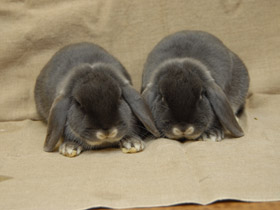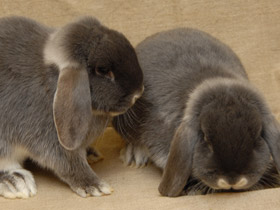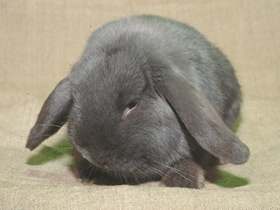The European rabbit (Oryctolagus cuniculus), or coney
The European rabbit (Oryctolagus cuniculus), or coney, is a species of rabbit native to southern Europe. It is the only rabbit species that has been domesticated and has given rise to all the modern variety of breeds.
Small animal: body length 31-45 cm, body weight 1.3-2.5 kg. The length of the ears is less than the length of the head, 6-7.2 cm. Feet are pubescent, claws are long and straight. The upper body colour is usually brownish-grey, sometimes with a reddish tinge. The tip of the tail is black or grey. Dark brown waviness formed by the ends of the pinnae is visible on the back. Black rims are distinguishable at the ends of the ears; ochre spots are on the neck behind the ears. Along the sides of the body there is a dull light-coloured stripe ending in a broad spot at the thigh. Abdomen white or light grey. The tail is brown-black above and white below.
Distribution
Currently, Oryctolagus cuniculus inhabit most areas of Western and Central Europe, Scandinavia, southern Ukraine, Crimea, North Africa; acclimatised in South Africa. On islands of the Mediterranean, Pacific and Atlantic oceans (in particular on the Azores, Canary Islands, Madeira, Hawaii) rabbits were released on purpose to breed and serve as a source of food for the crews of passing ships. The total number of islands where rabbits have been introduced reaches 500; for example, they live in a feral state on a number of islands in the Caspian Sea (Zhiloy, Nargen, Bullo, etc.), where they were introduced in the XIX century. In the middle of XVIII century rabbits were brought to Chile, from where they have already independently moved to the territory of Argentina. They were introduced to Australia in 1859 and a few years later to New Zealand. In the 1950s, rabbits from the San Juan Islands (Washington State) were released in the eastern United States.
Habitat
Oryctolagus cuniculus settle mainly in areas with shrubby vegetation and rugged terrain such as gullies, ravines, steep banks of seas and estuaries, and abandoned quarries. Less often they are found in forest belts, gardens, parks and very rarely in arable fields, where modern methods of land cultivation destroy its burrows. They do not avoid human neighbourhood, settling on the outskirts of settlements, on dumps and wastelands. They do not climb mountains higher than 600 metres above sea level. They do not move on the ice of frozen rivers even in case of hunger. The nature of the soil suitable for digging is important for rabbits; they prefer to settle on light sandy or sandy loam soils and avoid dense clay or stony areas. They dig their burrows with their claws.
Feeding
When feeding, Oryctolagus cuniculus do not move more than 100 metres from their burrows. Therefore, their diet is not selective, and the composition of food is determined by its availability. Feeding differs in winter and summer. In summer they eat green parts of herbaceous plants; in fields and vegetable gardens they feed on lettuce, cabbage, various root crops and cereals. In winter, in addition to dry grass, they often dig up underground parts of plants. Shoots and bark of trees and shrubs play a significant role in winter feeding.
Naming and etymology
Because of its non-British origin, the species does not have native names in English or Celtic, with the usual terms "cony" and "rabbit" being foreign loanwords. "Rabbit" is also pronounced as rabbidge, rabbert (North Devon) and rappit (Cheshire and Lancashire). More archaic spellings include rabbette (15th-16th centuries), rabet (15th-17th centuries), rabbet (16th-18th centuries), rabatte (16th century), rabytt (17th century) and rabit (18th century). The root word is the Walloon rabett, which was once commonly used in Liège. Rabett itself is derived from the Middle Dutch robbe, with the addition of the suffix -ett.
The term "cony" or "coney" antedates "rabbit", and first occurred during the 13th century to refer to the animal's pelt. Later, "cony" referred to the adult animal, while "rabbit" referred to the young. The root of "cony" is the old French connil or counil, of which the Norman plural was coniz, and later conis. Its forerunner is the Greek κύνικλος, from which the Latin cuniculus is derived. The origin of κύνικλος itself is unclear: Ælian, who lived during the third century, linked the word to Celtiberian and later authors relate it to its Basque name unchi; Varo and Pliny connected it to cuneus, which refers to a wedge, thus making reference to the animal's digging ability.
The species' dwelling place is termed a warren or cony-garth. "Warren" comes from the Old English wareine, itself derived from the Old French warenne, varenne, or garenne. The root word is the Low Latin warenna, which originally signified a preserve in general, only to be later used to refer specifically to an enclosure set apart for rabbits and hares. "Cony-garth" derives from the Middle English conygerthe, which may be a compound of connynge+erthe (cony+earth). The term stems from the Old French conniniere or coninyere, and later conilliere. The root word is the Low Latin cunicularia, the feminine form of the adjective cunicularius, which pertains to the rabbit.
Taxonomy
Originally assigned to the genus Lepus, the European rabbit was consigned to its own genus in 1874 on account of its altricial young, its burrowing habits, and numerous skeletal characters. It is superficially similar to the North American cottontails (Sylvilagus) in that they are born blind and naked, have white flesh, and little sexual dimorphism. However, they differ in skull characteristics, and cottontails do not construct their own burrows as the European rabbit does. Molecular studies confirm that the resemblance between the two is due to convergent evolution, and that the European rabbit's closest relatives are the hispid hare, the riverine rabbit, and the Amami rabbit. The oldest known fossils attributed to the modern European rabbit species are around 0.5 Ma (0.50 million yr) old (Middle Pleistocene).
Subespecies
- Oryctolagus cuniculus cuniculus, Linnaeus, 1758;
- Oryctolagus cuniculus algirus, Loche, 1858;
- Oryctolagus cuniculus brachyotus, Trouessart, 1917;
- Oryctolagus cuniculus cnossius, Bate, 1906;
- Oryctolagus cuniculus habetensis, Cabrera, 1923;
- Oryctolagus cuniculus huxleyi, Haeckel, 1874.
The European rabbit is the only rabbit to be widely domesticated, for food or as a pet. It was first widely kept in ancient Rome, where fetal rabbits were known as laurices and considered a delicacy, and has been refined into a wide variety of breeds during and since the Middle Ages.
Domesticated rabbits have mostly been bred to be much larger than wild rabbits, though selective breeding has produced a range of sizes from "dwarf" to "giant", which are kept as food animals and pets across the world. They have as much color variation among themselves as other livestock and pet animals. Their fur is prized for its softness; today, Angora rabbits are raised for their long, soft fur, which is often spun into yarn. Other breeds are raised for the fur industry, particularly the Rex, which has a smooth, velvet-like coat and occurs in a wide variety of colors and sizes.
Meat and fur
In the United Kingdom, rabbit was a popular food source for the poorer classes. Among wild rabbits, those native to Spain were reputed to have the highest meat quality, followed by those in the Ardennes. As rabbits hold very little fat, they were hardly ever roasted, being instead boiled, fried, or stewed.
The pelt of the rabbit is heavier and more durable than the hare's. Marshall calculated that the value of the skin in proportion to the carcass was greater than that of the sheep and ox. Its fur is primarily used for felting or hats. It is also dyed or clipped, and sold as imitations of more valuable furbearers, such as fur seal. Although cheap and easily acquired, rabbit fur has little durability.
Conservation status
Though the European rabbit thrives in many of the locations where it was introduced, in its native Iberia, populations are dwindling. In 2005, the Portuguese Institute for Nature Conservation and Forests classified O. cuniculus in Portugal as "near threatened", while in 2006, Spanish authorities (SECEM) reclassified it in Spain as "vulnerable". In 2018, the International Union for Conservation of Nature reclassified O. cuniculus in Spain, Portugal, and France as "endangered", due to the extent of recent declines. Worldwide, the species is also endangered.


















































